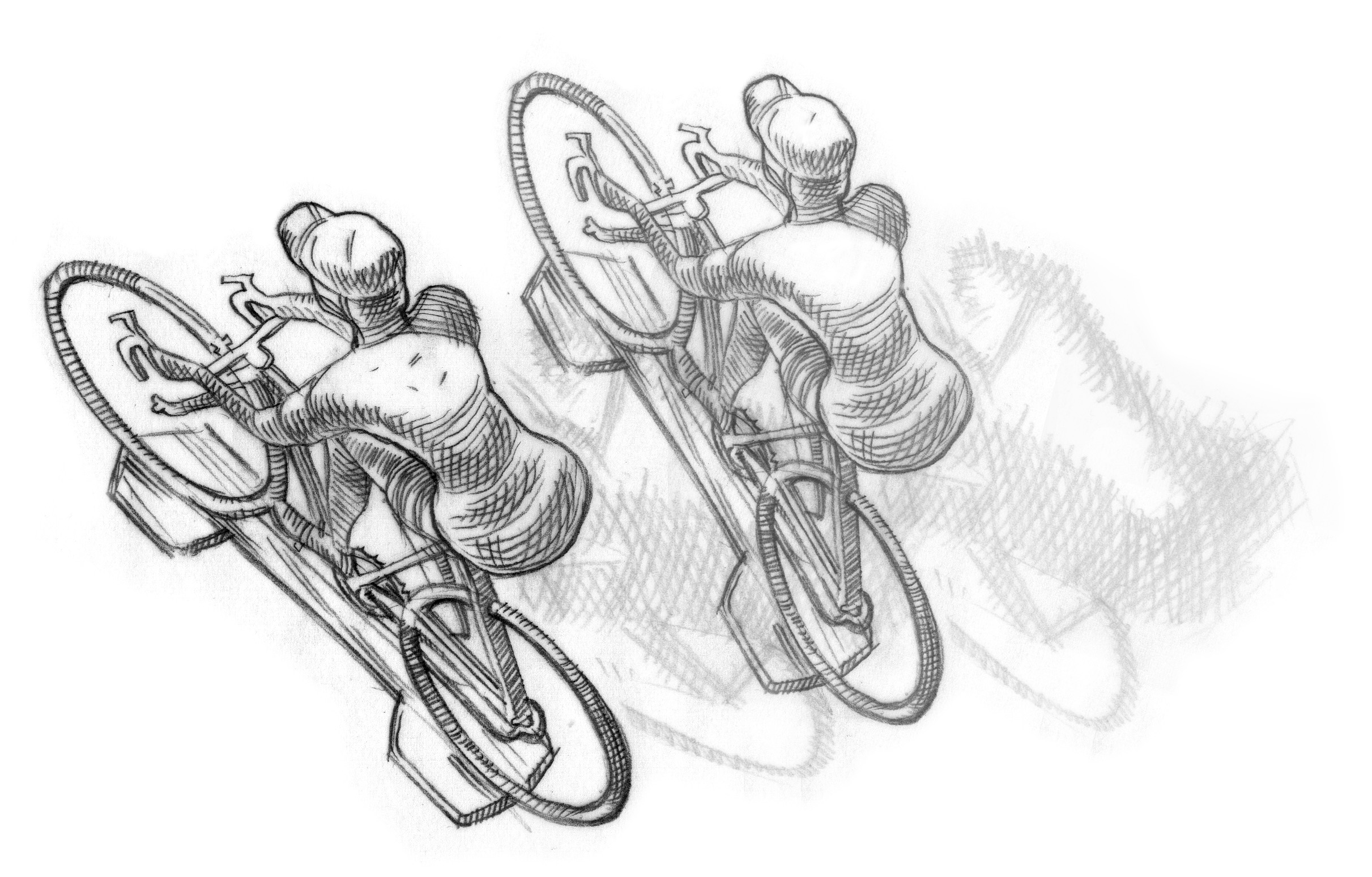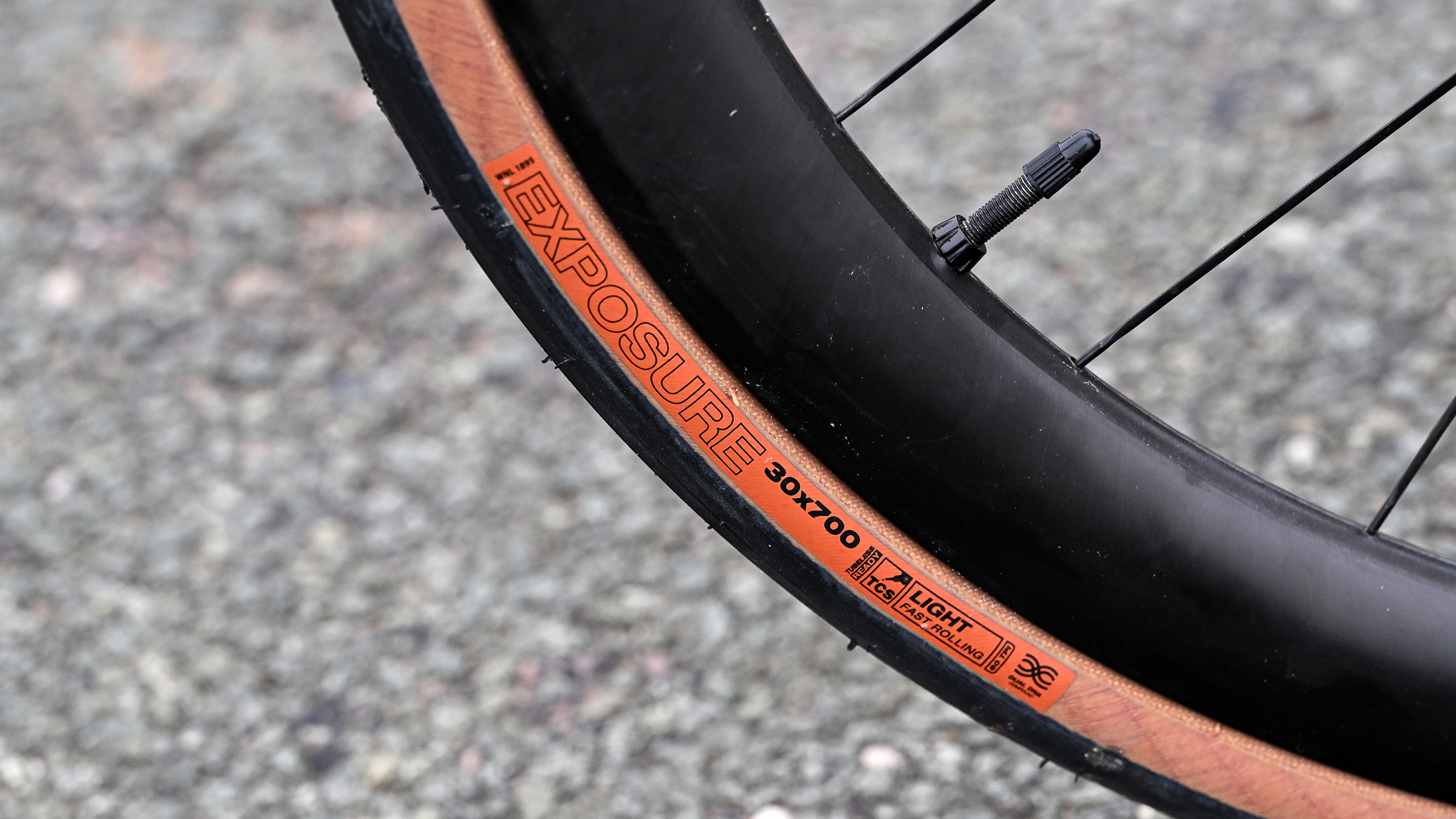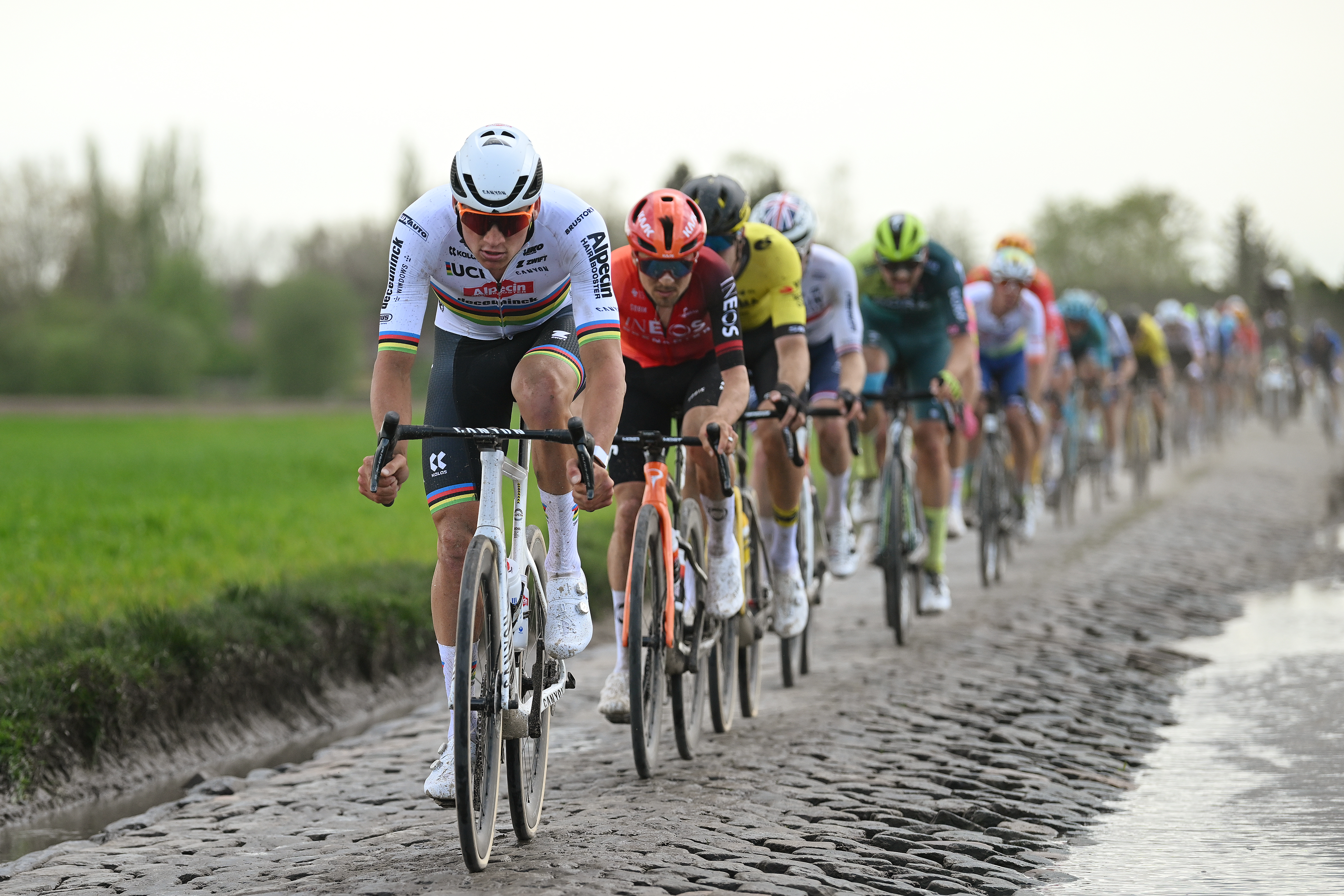Our man in the bunch 9: tactics
Cycle Sport’s Our Man in the Bunch series ran through the 2012 season, to popular acclaim. An anonymous professional rider sent us a series of dispatches from the peloton, covering all subjects from money, through media to management and more. We reproduce the series here.
Words by Our Man in the Bunch
Illustration by Simon Scarsbrook
This article originally appeared in Cycle Sport December 2012

Cycling is a complicated sport, often described as chess on wheels. For newcomers, trying to understand each team’s tactics in a race can be baffling. I’ve lost count of the number of times I’ve had to explain to people that the strongest rider can’t just ride off at the start. Bike racing has many nuances, a surprise attack by one team can end a race for another, while a badly-timed attack by even the strongest of riders can result in loss of time in the general classification of a stage race, or any hope of victory in a one-day event.
But who decides the team’s plan of attack before each race? How much can be decided in the pre-race meeting and how much has to be ‘ad lib’ on the road? Can one sports director, or team, really be that much more clever than another? How have race radios and power meters affected modern racing? It’s time to talk tactics, and it’s such a big subject, I’ll continue next month.
I’m going to start with the least tactical aspect of our sport, the individual time trial. On paper, it’s simple — the strongest rider should win. To a point. I’m going to disregard the big role played by aerodynamics, wind tunnel testing, and equipment choice which all have a bearing on the speed of a rider, but tactics come into play with, of all things, power meters.
Get The Leadout Newsletter
The latest race content, interviews, features, reviews and expert buying guides, direct to your inbox!
You might think that simply riding as hard as you can from start to finish is all you need to do to achieve the quickest time possible over any course, but the invention of power meters has shown that most riders, even professionals, are relatively poor at pacing through feel alone.
For example, a rider capable of averaging 400 watts for a one-hour test, will, without a power meter for pacing, likely ride at closer to 450 watts for the first 5-10 minutes, fade in the middle section having ridden at a power unsustainable for the full hour, then make a ‘comeback’ in the latter stages.
To the rider, it will feel like he has ridden as hard as he could from start to finish, but in reality, paced better, he could have averaged a higher power. Team Sky have employed a tactic or pacing strategy involving ‘negative splits,’ which means riding the first part of the event slightly below the power you know you can sustain for the entire duration, before increasing that effort and getting everything out of yourself for the second half. It’s almost always faster to ride this way but this strategy requires a huge amount of discipline from the rider, who will feel like he could be going a hell of a lot faster at the start.
Sports scientists and coaches have also started to come up with programs to calculate the most efficient pacing strategy for courses involving varying gradients and wind directions.
Again, you might think that for a rider who is capable of sustaining 400 watts for the duration, that riding at a consistent 400 watts for the entire event would result in the quickest time. Not so.
The difference between riding at 400 watts and freewheeling on a descent, might, depending on the gradient, be the difference between moving at 70kph or 75ph, while on a climb of a similar gradient, it would be the difference between riding at 25kph or going backwards. In short, it is more efficient to ride a little above your sustainable power on a climb, and somewhat below on the descents. It’s a complicated algorithm that few riders are using, but nevertheless, it’s a tactic that can change the results of a race, with the cleverer riders potentially outwitting the stronger.
Tactical teaser
But the tactics of time trials are child’s play compared to road races. I’m going to start by talking about the potential tactics you might adopt as a team defending the lead in a stage race. What you are looking for in any stage race is to make your lives easier, by saving energy, and also to maintain any advantage you have on your rivals.
I’ve talked previously of the misconception that the early break you see on your screens when the live coverage starts, is not simply composed of the few riders who fancied going up the road on that particular day. It can take seemingly endless permutations of breakaways before the right one is allowed some leeway. As a rider leading the GC, it should be your job to make sure that the inevitable breakaway works out the best for your interests.
The best tactic is to have another couple of team-mates high up on the general classification, although reality often intervenes here. It’s perhaps one of the more obvious tactics, but allowing these riders to cover the larger moves at the start of a stage can put rival teams on the back foot, especially if your team-mate up the road is the best placed rider of the breakaway. The rider in front can even play the ‘I’m only defending my team-mate’s jersey’ card, and not even contribute to the work, while other teams are forced to chase behind. It won’t make him popular, but we’re after an easy life, not popularity.
In the more normal event that you don’t have any other team-mates close on the GC, some more subtle tactics can be deployed.
Is it a sprint stage? If so, make sure you don’t let anyone from the sprinters’ teams disappear up the road, thus giving them an excuse not to assist in the chase. Did you see the Australians leaving the chasing to the Brits in the Olympic road race, even though they had Matt Goss on their team? They had Stuart O’Grady up the road, so they were off the hook.
Is it an intermediate or mountainous stage? Why not try letting one of the riders at around 8-12 minutes sneak off in a breakaway — he is going to encroach on other riders’ places in the GC before he encroaches on you, which often makes teams panic and send riders to the front to either aid the chase or take over completely.
Is the team classification still up for grabs? If so, why not try and keep the leading team in check while allowing their rival teams a little freedom? Again, it could force the leading team to panic and aid/take over the chase.
Understanding the ‘home team’ card can also be of value. Leading the Tour of Colorado? Don’t let Garmin go up the road. Leading the Tour of Denmark? Don’t let Saxo move. In the gold jersey at the Tour of Britain — keep team Sky in check. There is often a lot of pressure on the home teams at these races, so even if they aren’t leading the overall, they also can’t afford to waste the opportunity of stage wins, and thus will help you in the chase. All of these tactics make our lives as race lead defenders as easy as possible.
One-day races can be a little different. Before the flag drops nobody is currently leading the race, so whose job is it to control things? Again, you can think about the ‘home team’ card. For example, if, as a foreign team, you have an outside chance of winning the Tour of Flanders, it’s a wise idea not to let Omega Pharma-Quick Step get a rider in the early breakaway. As the home team with the overwhelming favourite (Boonen), they will have the weight of responsibility to chase the early move, while you can save as many riders as possible for the crucial points of the race.
The tactics for covering the early moves can be endless but in my experience, you don’t want to try and be too clever. I was once in a team leading a week-long stage race overall, and our DS wanted to win the race by riding the most intelligently. In the end, on one stage, we gambled that other teams would chase, but they didn’t, and in a race that we were strong enough to win, we lost by trying to be too smart.
Those are some of the tactics you can use if you are leading a race, but what about if you are trying to dethrone a rival team?
Isolating the leader
I was once in a five-day race where we had riders in second, fourth and seventh, all relatively close to the leader going into the last stage. His team-mates were all well down on the GC, having worked hard to defend his lead for three stages.
In the team meeting before the last stage, which was undulating but not mountainous, it was decided we would do everything we could to get our fourth or seventh place rider up the road near the start. It worked — after around 40 kilometres of attacking, a strong group of six formed, including our fourth-placed rider who was just a couple of minutes back on the GC. The usual lull followed as the overall leader stopped for a pee with half of the peloton, allowing the gap up to a relatively small 2-30 before getting his team to the front to start controlling things. The breakaway group was supremely strong however, and the leading team soon decided that having only three riders ‘pulling’ on the front wasn’t enough to bring the gap down, and consequently put a fourth, fifth, and eventually sixth rider on the front.
It had the desired effect. The gap, which had peaked at 4-30, gradually started to come down, reaching 1-30 with 35 kilometres to go. They appeared to finally have things under control, all they had to do was keep riding at that pace — they didn’t need to bring the break back, just make sure that it was under two minutes when we crossed the line (there were no bonus seconds on offer).
At this point, our DS came up with the next phase of our plan. He sent our team on the attack from the bottom of a three-kilometre climb that crested 25 kilometres before the finish line.
The leader had plainly been much stronger than our second-placed rider for the entire race, and would have no trouble in covering any attacks. His team-mates, on the other hand, who had been working all day, were on their knees. As soon as they saw us raise the pace on the climb, their heads dropped, they sat up — their job for the day was done.
At the front, we went as hard as we could to the top of the climb, forming a group of 15, with three of us, and the yellow jersey, who was now on his own.
By the top, the gap to the breakaway was down to 1-15, well within the comfort zone for the leader of the race, but at this point, we sat up. The idea had been just to isolate him and kill the morale of his team-mates, and it worked. With 25 kilometres to go, he had a choice, he could either plough a lonely furrow on the front of the group and risk getting attacked at the end, or wait for his team to regroup.
He chose the latter, but by the time even just two of his team-mates had made it back to us, the gap had increased to over three minutes. They had nothing left, and were unable to make any inroads to the riders in front. The yellow jersey was forced to ride on the front, which did bring the gap down, but not by enough, and our team-mate up the road went on to bag the overall. To add insult to injury, our second-placed rider, once sure that our team-mate was certain of overall victory, attacked the yellow jersey, taking enough time to give us first and second place on the final podium.
Our man in the bunch: More articles in the series >>

Thank you for reading 20 articles this month* Join now for unlimited access
Enjoy your first month for just £1 / $1 / €1
*Read 5 free articles per month without a subscription

Join now for unlimited access
Try first month for just £1 / $1 / €1
-
 WTB Exposure TCS - a 'fast adventure road tyre'
WTB Exposure TCS - a 'fast adventure road tyre'The WTB Exposure TCS tyre offers an enticing combination of comfort, speed and durability aimed at pretty much everyone except racers
By Tim Russon Published
-
 Tadej Pogačar's historic debut, Lotte Kopecky at the double and a new Arenberg diversion: Everything you need to know about Paris-Roubaix and Paris-Roubaix Femmes
Tadej Pogačar's historic debut, Lotte Kopecky at the double and a new Arenberg diversion: Everything you need to know about Paris-Roubaix and Paris-Roubaix FemmesThe Hell of the North happens this weekend - here's how to watch, who to watch, and what to watch out for
By Adam Becket Published